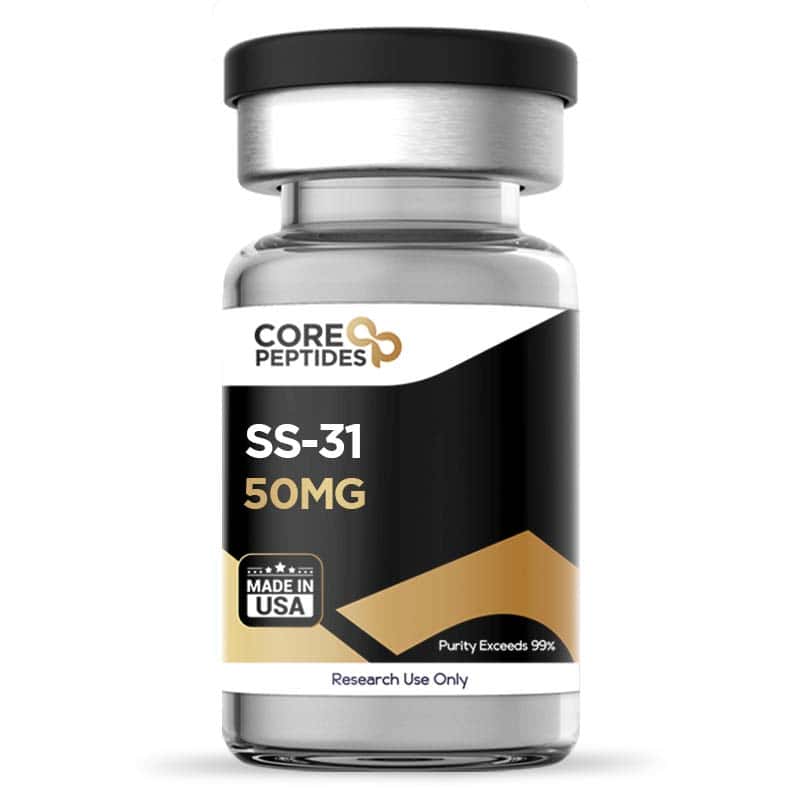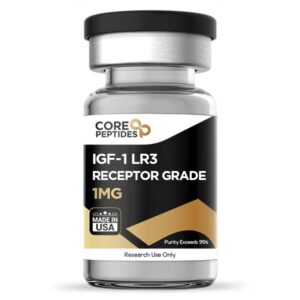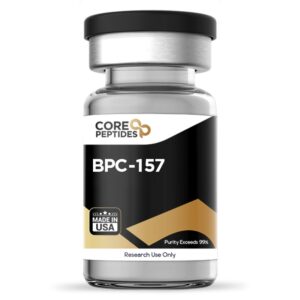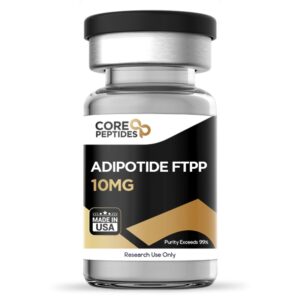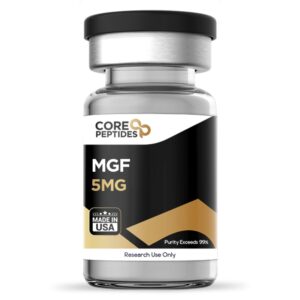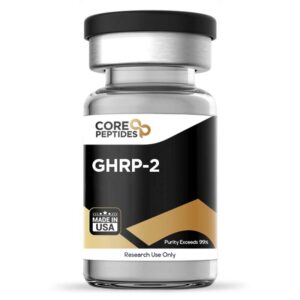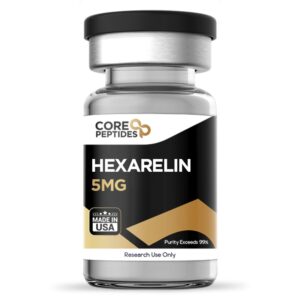SS-31 (50mg)
$263.00
Size: 50mg
Contents: SS-31
Form: Lyophilized powder
Purity: >99%
SKU: P-SS-31-50
FREE Shipping on $200+ orders
Discount per Quantity
| Quantity | Discount | Price |
|---|---|---|
| 5 - 8 | 5% | $249.85 |
| 9 + | 10% | $236.70 |
SS-31 Peptide
SS-31 (Szeto-Schiller-31), also known as MTP-131, is a tetrapeptide that has garnered interest for its potential properties related to mitochondrial dysfunction.(1) With a unique characteristic of holding a cationic 3+ charge at physiological pH, this molecule appears to permeate cell membranes with ease and potentially traverses the blood-brain barrier. It has been suggested to rapidly exit cells, despite not being a substrate for P-glycoprotein. One of the most researched attributes of SS-31 is its potential to accumulate in the inner mitochondrial membrane at concentrations that appear to be over 1000 times greater than in plasma. There, the peptide may display a potential affinity for cardiolipin, an anionic phospholipid exclusively found in the inner mitochondrial membrane. This binding has been suggested to disrupt the interactions between cardiolipin and cytochrome C, leading to a reduction in the oxidative inactivation of cardiolipin by cytochrome C. The mechanism may involve inhibiting the peroxidase activity of cytochrome c, while preserving Met80-heme ligation and favoring its electron carrier activity by SS-31. Given that cardiolipin has been suggested to play a pivotal role in optimizing mitochondrial electron transport and ATP production, this disruption has significant potential. It may help in the formation of mitochondrial cristae, ensuring efficient oxidative phosphorylation and minimizing the leakage of reactive oxygen species.
Chemical Makeup
Molecular formula: C32H49N9O5
Molecular weight: 639.8 g/mol
Sequence: D-Arg-dimethylTyr-Lys-Phe-NH2
Other known titles: MTP-131
Research and Clinical Studies
Below we have extracted information from the latest clinical and preclinical data on the potential actions of SS-31 as reported by various research models.
SS-31 and Oxidative Stress
Oxidative stress is posited as the principal factor in the development of a wide range of pathologies, such as retinopathy. Thus a study involving а murine model of diabetic retinopathy aimed to investigate the impact of SS-31.(2) Following two weeks post-diabetes induction, Szeto-Schiller-31 or saline was introduced to these models for a duration of four months. Then, the structural integrity of the inner blood retinal barrier was evaluated using Evans blue dye (EBD) perfusion. To further analyze the potential outcomes, the distribution of claudin-5 and occludin (maintaining the integrity of barriers in tissues), as well as acrolein, 8-OHdG, and nitrotyrosine (markers of oxidative stress and damage) in the retinal tissues was assessed through immunofluorescent staining. Additionally, the intricate retinal structures were examined using transmission electron microscopy. The concentration of proteins related to cell growth and apoptosis such as VEGFR2, Trx-2, Bcl-2, Bax, caspase-3, p53, and NF-κB in the retinas was evaluated using western blot techniques. Four months post-exposure, murine models exposed to SS-31 displayed several apparent results, including improved retinal cell structures, refined capillary basement membrane composition, decreased inner blood retinal barrier permeability, more consistent staining for claudin-5 and occludin, and diminished levels of acrolein, 8-OHdG, nitrotyrosine, Bax, caspase-3, p53, and NF-κB. In contrast, Trx-2 (protects from oxidative stress) and Bcl-2 (protects from cell death) levels appeared to be enhanced. This suggests that SS-31 appears to bolster retinal structures and counteract the degradation of the inner blood retinal barrier.
SS-31 and Aging
SS-31 may exhibit potential actions against aging, as posited by a trial examining the actions of the peptide on cardiac proteins in aged murine models.(3) The study delved into the potential of SS-31 on post-translational modifications of heart proteins. The myocardium of aged murine models had an apparent rise in the oxidation of protein thiols (sulfur-containing groups in proteins), indicated by the enhanced S-glutathionylation of cysteine residues, especially when compared to young murine models. An 8-week intervention with SS-31 appeared to almost entirely reverse this age-associated proteomic oxidation. The authors commented that significant shifts were apparently detected, predominantly in proteins purported as important for mitochondrial or cardiac function. Further, age-correlated modifications in the murine heart appeared to undergo partial reversal post SS-31 exposure. More specifically, the researchers noted “changes in the mouse heart phosphoproteome that were associated with age, some of which were partially restored with elamipretide.” Thus, the findings suggest that alterations in the thiol redox state and phosphorylation status could be pathways through which aging may impact murine heart functionality. Importantly, these age-induced changes seem to be mitigated with SS-31 influence.
SS-31 and Mitochondrial Dysfunction
Mitochondrial dysfunction is thought to be a major part of the mechanisms which occur in pathological processes, as well as certain physiological but unfavorable phenomena such as sarcopenia - the reduction in size of muscle tissue in advanced age.(4) To explore the potential of enhancing mitochondrial function as a countermeasure, a study was conducted using SS-31 to investigate if it could amend redox balance and boost skeletal muscle cells functionality in aged murine models. Young and older female C57BL/6Nia murine models underwent an 8-week exposure to SS-31. Assessments of mitochondrial function in vivo utilized optical and magnetic resonance spectroscopy. Findings suggested that SS-31 may have counteracted the age-related decrease in peak mitochondrial ATP production and enhanced the efficiency of oxidative phosphorylation (P/O). Intriguingly, even with this mitochondrial boost, mitochondrial protein expression remained constant or even declined in the exposed older murine models. The respiration in permeabilized gastrocnemius muscle fibers displayed no significant difference between the older and the SS-31-exposed older models. Additionally, SS-31 was posited to realign redox homeostasis in aged skeletal muscle cells. Apparently, there was a more balanced glutathione redox status, and thiol redox proteomics suggested a significant reversal of cysteine S-glutathionylation post-translational modifications across the skeletal muscle proteome. Furthermore, the gastrocnemius muscle cells in the Szeto-Schiller-31 exposed older murine models showcased potentially increased fatigue resistance and an apparent mass enhancement compared to unexposed controls.
SS-31 and Neuroprotection
SS-31 has been suggested to provide neuroprotection in a range of experimental models. Its function as a mitochondrial reactive oxygen species (ROS) scavenger and the inherent mechanisms in neuronal injury remain elusive. Yet, one trial aimed to delve into the neuroprotective potential of SS-31 and comprehend any apparent mitochondrial alterations using murine models of neuronal injury.(5) Murine models were categorized into sham, neuronal injury, neuronal injury + vehicle, and neuronal injury + SS-31 groups. The peptide SS-31 or vehicle was introduced post-neuronal injury, and brain specimens were procured 24 hours thereafter for analysis. The introduction of SS-31 appeared to counteract mitochondrial impairment and lessened secondary neuronal injury. It may directly reduce the reactive oxygen species content, rejuvenate the activity of superoxide dismutase (SOD), lower malondialdehyde (MDA) levels, and curb the release of cytochrome C, thereby mitigating potential neurological impairments, brain hydration, DNA destruction, and neural apoptosis. Additionally, SS-31 appeared to have reinstated the SIRT1 expression and amplified the nuclear relocation of PGC-1α, as suggested by Western blot and immunohistochemistry. Collectively, these findings suggest that SS-31 enhances mitochondrial function and may confer neuroprotection in murine models post-neuronal injury, possibly via augmented mitochondrial rebirth.
SS-31 and Metabolic Conditions
Studies have investigated the potential mechanisms and effects of SS-31 on leukocytes from models with type 2 diabetes (T2D), focusing on oxidative stress, endoplasmic reticulum (ER) stress, and autophagy.(6) The trial included samples from models of type 2 diabetes and controls. Key metrics such as anthropometric and analytical measurements were considered. Results indicated that leukocytes from the T2D models exhibited increased levels of reactive oxygen species (ROS), elevated calcium content, and pronounced expression of ER stress markers like GRP78 and CHOP. However, exposure to SS-31 appeared to significantly mitigate these elevated levels, hinting at its possible protective effects. Similarly, SS-31 appeared to have led to a decrease in BECN1 gene expression, along with reductions in Beclin1 and LC3 II/I protein expressions. Conversely, the protein levels of p62, which were found to be reduced in type 2 diabetes models, appeared rejuvenated post SS-31 exposure. An interesting observation was that SS-20, a compound without antioxidant activity, did not manifest any noticeable change in the parameters studied. Additionally, SS-31 may have exhibited properties that impacted leukocyte-endothelium interactions. Specifically, in type 2 diabetes models, it appeared to reduce rolling flux and leukocyte adhesion, while enhancing rolling velocity. Thus, the researchers commented that “SS-31 exerts potentially beneficial effects on leukocytes of T2D patients modulating oxidative stress and autophagy, and ameliorating endoplasmic reticulum stress.”
SS-31 and Kidney Function
Ischemia is a pathological condition which leads to organ injury such as acute kidney injury as a result of ATP depletion. Thus, swift recovery of ATP upon reperfusion is vital to reduce tissue damage. However, ATP recovery is often delayed since ischemia damages the mitochondrial cristae membranes, which are essential for mitochondrial ATP synthesis. The mitochondria-targeted compound SS-31 has been suggested to quicken ATP recovery post-ischemia and potentially diminish acute kidney injury. In one investigation, scientists utilized a polarity-sensitive fluorescent analog of SS-31 to show that SS-31 may bind with high affinity to cardiolipin that is crucial for cristae formation.(7) Moreover, the SS-31/cardiolipin complex appeared to shield its heme iron and thus impede cytochrome C peroxidase activity, a reaction responsible for cardiolipin peroxidation leading to mitochondrial damage during ischemia. When murine models were exposed to SS-31, it appeared to safeguard the cristae membranes during renal ischemia, averting mitochondrial swelling. Immediate recovery of ATP upon reperfusion may also enable the speedy repair of ATP-dependent processes, such as the reformation of the actin cytoskeleton and cell polarity. This swift ATP recovery may also work to suppress apoptosis, fortify tubular barrier function, and alleviate renal dysfunction. Thus, Szeto-Schiller-31 may potentially preserve mitochondrial cristae by engaging with cardiolipin on the inner mitochondrial membrane.
SS-31 and Cachexia
Cachexia is a multifaceted condition representing on a cellular level a diminished oxidative capability accompanied by low intracellular ATP, both of which stem from compromised mitochondrial functionality. Thus, one study aimed to assess the potential of SS-31 in mitigating muscle degradation and metabolic disturbances in C26-bearing (colon adenocarcinoma model) murine models, some of which underwent combination exposure of oxaliplatin and 5-fluorouracil for additional cachexia inducement.(8) C26-bearing murine models showcased mitochondrial impairments that were linked to changes in cardiolipin fatty acid chains. By specifically targeting cardiolipin using SS-31, there was suggested to be an apparent moderate reduction in overall body wasting, and a notable prevention of glycolytic myofiber area reduction. Furthermore, SS-31 may have enhanced the muscle mitochondrial activity of succinate dehydrogenase (SDH) and successfully reinstated intracellular ATP concentrations. However, SS-31 did not appear to negate the loss of mitochondrial proteins. When the SS-31 exposure was increased progressively in C26 OXFU murine models, there were observable short-lived positive outcomes in terms of body and muscle weight retention, prior to these models entering a non-responsive, terminal stage by day 28. Notably, Szeto-Schiller-31 may have been effective in thwarting the loss of mitochondria and aberrant autophagy/mitophagy processes. Comprehensive analyses of metabolomes in skeletal muscles, liver, and plasma unveiled pronounced disruptions in energy and protein metabolic pathways in murine models with C26. SS-31 displayed a potential to partially regulate metabolomes in skeletal muscles and the liver, indicating an apaprent enhancement in systemic energy equilibrium.
SS-31 and Tendinopathies
Studies have investigated the potential role of SS-31 in improving mitochondrial function in tenocytes (cells of tendons), hypothesizing that SS-31 may enhance mitochondrial function in tenocytes from models with tendinopathy. For one study, tenocytes were sourced from two sets: one from healthy hamstring tendons and the other from degenerative supraspinatus tendons. (9) These cells were cultured and then allocated into four distinct categories, including SS-31-exposed and unexposed tenocytes from each category. Several outcome metrics were used, including measurements related to mitochondrial potential, detailed mitochondrial imagery via transmission electron microscopy, and assessments of reactive oxygen species, superoxidative dismutase activity, gene expression, and cell viability. The findings of the study indicated that degenerative tenocytes may have had a higher proportion of cells with depolarized mitochondria. However, post SS-31 exposure, a decrease in this proportion was apparently observed. Transmission electron microscopy also suggested that degenerative tenocytes had fewer mitochondria, and these were also smaller in size. However, Szeto-Schiller-31 seemed to improve these morphological deficits. There was no notable difference in reactive oxygen species levels between the two types of tenocytes, but the activity levels of superoxidative dismutase appeared to be discernibly lower in the degenerative set. This activity level appeared to increase after the introduction of SS-31, implying potential recovery of mitochondrial functionality. Further, certain genes linked to matrix remodeling and fatty infiltration were more active in degenerative tenocytes. Interestingly, the activity of these genes decreased after SS-31 exposure. Other genes related to cellular responses to hypoxic conditions and apoptosis regulation also appeared to exhibit increased activity in the degenerative group. Overall, these findings in the murine models suggest that SS-31 may possess potential benefits in ameliorating mitochondrial dysfunction in tenocytes, offering potential avenues for future research.
SS-31 peptide is available for research and laboratory purposes only. Please review and adhere to our Terms and Conditions before ordering.
References:
- Pang, Y., Wang, C., & Yu, L. (2015). Mitochondria-Targeted Antioxidant SS-31 is a Potential Novel Ophthalmic Medication for Neuroprotection in Glaucoma. Medical hypothesis, discovery & innovation ophthalmology journal, 4(3), 120–126.
- Huang, J., Li, X., Li, M., Li, J., Xiao, W., Ma, W., Chen, X., Liang, X., Tang, S., & Luo, Y. (2013). Mitochondria-targeted antioxidant peptide SS31 protects the retinas of diabetic rats. Current molecular medicine, 13(6), 935–945. https://doi.org/10.2174/15665240113139990049
- Whitson, J. A., Martín-Pérez, M., Zhang, T., Gaffrey, M. J., Merrihew, G. E., Huang, E., White, C. C., Kavanagh, T. J., Qian, W. J., Campbell, M. D., MacCoss, M. J., Marcinek, D. J., Villén, J., & Rabinovitch, P. S. (2021). Elamipretide (SS-31) treatment attenuates age-associated post-translational modifications of heart proteins. GeroScience, 43(5), 2395–2412. https://doi.org/10.1007/s11357-021-00447-6
- Campbell, M. D., Duan, J., Samuelson, A. T., Gaffrey, M. J., Merrihew, G. E., Egertson, J. D., Wang, L., Bammler, T. K., Moore, R. J., White, C. C., Kavanagh, T. J., Voss, J. G., Szeto, H. H., Rabinovitch, P. S., MacCoss, M. J., Qian, W. J., & Marcinek, D. J. (2019). Improving mitochondrial function with SS-31 reverses age-related redox stress and improves exercise tolerance in aged mice. Free radical biology & medicine, 134, 268–281. https://doi.org/10.1016/j.freeradbiomed.2018.12.031
- Zhu, Y., Wang, H., Fang, J., Dai, W., Zhou, J., Wang, X., & Zhou, M. (2018). SS-31 Provides Neuroprotection by Reversing Mitochondrial Dysfunction after Traumatic Brain Injury. Oxidative medicine and cellular longevity, 2018, 4783602. https://doi.org/10.1155/2018/4783602
- Escribano-López, I., de Marañon, A. M., Iannantuoni, F., López-Domènech, S., Abad-Jiménez, Z., Díaz, P., Solá, E., Apostolova, N., Rocha, M., & Víctor, V. M. (2019). The Mitochondrial Antioxidant SS-31 Modulates Oxidative Stress, Endoplasmic Reticulum Stress, and Autophagy in Type 2 Diabetes. Journal of clinical medicine, 8(9), 1322. https://doi.org/10.3390/jcm8091322
- Birk, A. V., Liu, S., Soong, Y., Mills, W., Singh, P., Warren, J. D., Seshan, S. V., Pardee, J. D., & Szeto, H. H. (2013). The mitochondrial-targeted compound SS-31 re-energizes ischemic mitochondria by interacting with cardiolipin. Journal of the American Society of Nephrology : JASN, 24(8), 1250–1261. https://doi.org/10.1681/ASN.2012121216
- Ballarò, R., Lopalco, P., Audrito, V., Beltrà, M., Pin, F., Angelini, R., Costelli, P., Corcelli, A., Bonetto, A., Szeto, H. H., O'Connell, T. M., & Penna, F. (2021). Targeting Mitochondria by SS-31 Ameliorates the Whole Body Energy Status in Cancer- and Chemotherapy-Induced Cachexia. Cancers, 13(4), 850. https://doi.org/10.3390/cancers13040850
- Zhang, X., Zhang, Y., Zhang, M., Nakagawa, Y., Caballo, C. B., Szeto, H. H., Deng, X. H., & Rodeo, S. A. (2022). Evaluation of SS-31 as a Potential Strategy for Tendinopathy Treatment: An In Vitro Model. The American journal of sports medicine, 50(10), 2805–2816. https://doi.org/10.1177/03635465221107943
